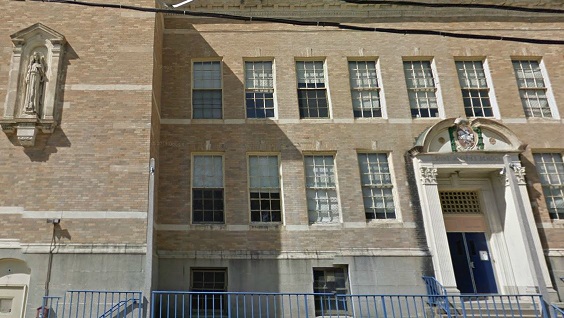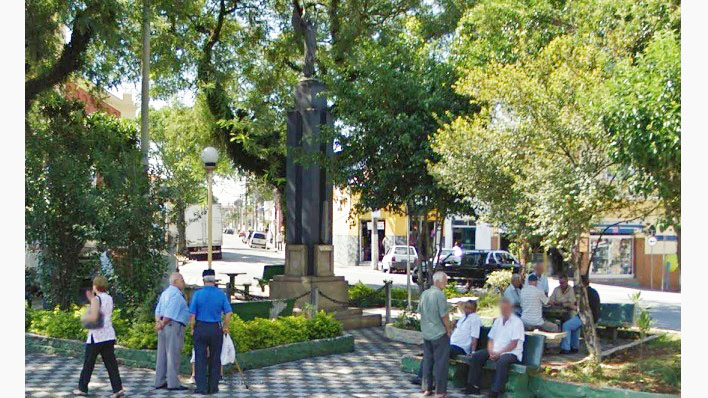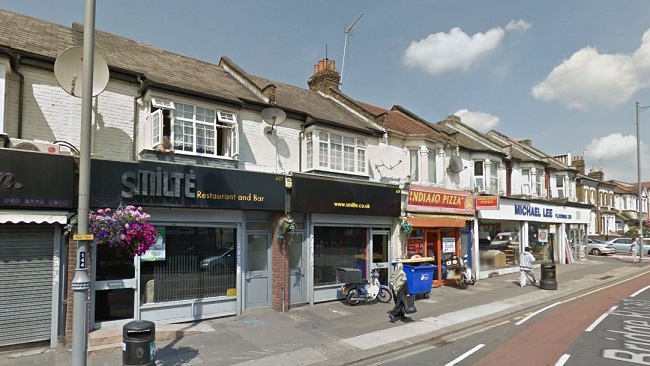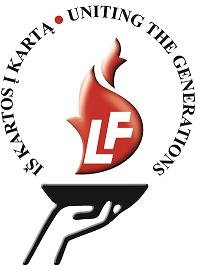Top Lithuanian locations outside Lithuania
Author of the article: ©Augustinas Žemaitis.
There are hundreds of Lithuania-related locations in the world. This article is the first attempt to list the most interesting Lithuania-related sites of different epochs, ranging from Medieval castles to Lithuanian American churches to the graves of Soviet Genocide victims in Siberia; from historic communities to contemporary influences.
Here we offer top 10 of Lithuanain heritage types with a single "top" location and the "best alternative" in every Group.
1.Grand Duchy of Lithuania castles and palaces
Top location: Lithuanian castles in Belarus. Some of the prettiest and most important castles of Grand Duchy of Lithuania now stand just beyond the boundaries of Lithuania, in modern-day Belarus: from the manicured Nesvyžius (Nesvizh) and Myrius (Mir) to ruined Ružanai (Ruzhany), Naugardukas (Navahrudak) and Krėva (Krevo). Whether you fancy reconstruction of old buildings or you believe they should be left untouched, you will find what you will like in Belarus.

Myrius (Mir) castle in the evening. ©Augustinas Žemaitis.
Top alternative: Lithuanian castles in Western Ukraine. They may be somewhat lesser known but many are especially great. Some are renovated as museums (e.g. Kamenets Podilskiy and Lutsk), others are ruined (e.g. Ostroh, Staroselo), and yet others repurposed (e.g. Olyka). Ukraine was especially important to Lithuania for the ~150 years Lithuanians ruled Ukraine. The land was so populous that there were more Ukrainians than Lithuanians in the Grand Duchy at the time. However, as the Lithuanian era was shorter there than in Belarus, many castles have non-Lithuanian portions as well.

Kamenets Podilskiy castle in Ukraine. ©Augustinas Žemaitis.
2.Lithuanian-American cities
Top location: Chicago. Having a population of some 80000 Lithuanians Chicago is the capital of Lithuanian-Americans, or maybe even of Lithuanian diaspora as a whole. While Lithuania was under Soviet occupation (1940-1990) Chicago served as the shadow capital of free Lithuania, where HQs of many banned Lithuanian patriotic and religious organizations operated. Chicago was also the home city of luminaries such as pilots Darius and Girėnas and president Valdas Adamkus. Back ~1960s Chicago had the largest Lithuanian district outside Lithuania (Marquette Park, ~30000 Lithuanians among a population of ~45000). It still has the world‘s largest Lithuanian museum and the largest Lithuanian church outside Lithuania. Chicago‘s Lithuanian cemeteries surpass are equal in size to graveyards of entire towns. Chicago has been attracting Lithuanians since the 19th century when it had more Lithuanians than any other city in the world (Vilnius and Kaunas included). It also had 14 Lithuanian churches (more than in any city until 1990), many of which still stand although fewer are still Lithuanian. Chicago also has a multitude of Lithuanian monuments and the oldest continuously published Lithuanian newspaper in the world (Draugas, est. 1909).

Famous Baroque revival church of Holy Cross (1913) in Chicago (left) with a Lithuanian plaque (right). ©Augustinas Žemaitis.
Top alternative: New York. The second US city in the number of Lithuanians, it hosts several Lithuanian churches, a monument to king Jogaila and a square of Darius and Girėnas.
Other alternatives: Philadelphia, Baltimore, Boston, Detroit, Cleveland, Pittsburgh, Washington (DC), Worcester, Los Angeles. Each of these American cities (and many others) have something Lithuanian within their limits: churches, plaques, cemeteries, parks, small museums, inscriptions, etc.

Lithuanian Hall in Detroit. ©Augustinas Žemaitis.
3.Lithuanian towns and villages in the USA
Top location: Pennsylvania coal region. It was the first overseas land where Lithuanians set off to seek for a better living standart than in their Russian-occupied homeland. This happened soon after serfdom was abolished in Lithuania ~1865, which has allowed a legal free movement of peasants for the first time. Lithuanians worked in Pennsylvanian coal mines. To this day the towns have high numbers of Lithuanians (~10% in some), there is a multitude of Lithuanian churches and cemeteries. The probability that a random local will have a surname ending in "is" or "as" is not that low. Pennyslvania Coal Region (rather than Vilnius or Karaliaučius) was a location where the first Lithuanian novel was published (1904), the first Lithuanian brass orchestra was established. There are Lithuanian toponyms as well. While today most Pennsylvania Lithuanians no longer speak Lithuanian (after all, 3-4 generations have already departed this world), they still cherish other Lithuanian traditions such as weaving, dances and cuisine. Coal Region's "Lithuanian days", celebrated annually since 1914, are the oldest ethnic festival in the USA.

Mount Carmel Lithuanian Social Club (Pennsylvania), established in 1926. Google Street View.
Top alternative: Connecticutm, boasting the highest percentage of Lithuanian-ancestry people (1%) among US states. Connecticut has numerous Lithuanian churches as well as the Lithuanian Putnam monastery that organizes annual Lithuanian festival and has a museum made of Lithuanian pavilion from EXPO 1939 exhibition.

St. Joseph Lithuanian church in Waterbury (Connecticut). Built in 1925 it is adorned by various sculptures and Vytis. Google Street View.
4.Soviet-destroyed Lithuania
Top location: Lithuania Minor (Kaliningrad Oblast). What is now Kaliningrad Oblast of Russia was once inhabited mainly by ethnic Lithuanians. The city of Koenigsberg (Lithuanian: Karaliaučius, Russian: Kaliningrad) was where the first Lithuanian books were printed ("Cathechism" by Martynas Mažvydas, "Metai" by Kristijonas Donelaitis). At the time Lithuanian press was banned in Russian-occupied Lithuania and knygnešiai (book smugglers) would bring it in secretly from Lithuania Minor. According to a common 19th century view Lithuanians were a partitioned nation, part of which was ruled by Russia and the other part (Lithuania Minor) by Prussia (in the same way as e.g. Poland was partitioned at the time). While many people of Lithuania Minor gradually Germanized, large Lithuanian populations (comprising the majority in some locations) survived well into 20th century. Lithuania Minor was, however, all but destroyed by the Soviet Union's Genocide of Lithuania Minor, which resulted in murders some 130 000 Lithuanians in the area and deportations of the rest. All Lithuanian placenames were changed into newly-coined Russian ones (mostly related to communism and Russia). If you want to feel Lithuania Minor (and the tragedy of its destruction) today, you should travel in Kaliningrad Oblast using numerous books, old maps and pictures.

Former church of Tolminkiemis transformed into Kristijonas Donelaitis museum. It is one of the few remaining Lithuanian locations in Kaliningrad Oblast. Soviets allowed such museum likely because Kristijonas Donelaitis has written against the rich. ©Augustinas Žemaitis.
Top alternative: Locations of the Lithuanian exile. Many victims of the Soviet Genocide were not immediately murdered. They were exiled to GULAG concentration camps or other locations far within Soviet Union, where most of them later died of cold, malnutrition or overwork. There are countless places of such exile. Most of them have hard-to-find crumbling cemeteries with equally shabby small monuments that were constructed by the Soviet Genocide survivors after 1990 when that became possible. In order to better understand the tormenting exile one should perhaps visit the sites in winter, when temperatures of -30 are normal while in some locations it may even get under -60. As Russia still largely denies the Soviet genocide, memorial building is difficult there (even Lithuanian-funded memorials were often refused). An interesting memorial, however, stands in Kengyr GULAG of modern-day Kazakhstan: a symbolic cemetery where every gravestone reminds of a nation that suffered under the Soviet regime (among them Lithuanians).

Images of exiled Lithuanians cemetery in Irkutsk region of Russia. Mission Siberia expedition photo.
5.Political centers of Europe
Top location: Rome. Rome has been the heart of Catholic world for centuries. Once Lithuania Christianized (14th century), a part of Lithuania's political life has unavoidably moved to Rome. The "Eternal city" may be visited without seeing a single Lithuanian object, but those that exist there are interesting: a Lithuanian chapel within the Pope's St. Peter Cathedral itself, castle-like representative office of Lithuanian priests, an interwar Villa Lituania Lithuanian embassy that was illegally ceded to Russians, as well as graves of many Lithuanians (Renaissance era cardinal Radvila to 20th century politicians).

Representation office of Lithuanian priests in Rome as well as a guest house for Lithuanian pilgrims. The fence is adorned by Crosses of Vytis while the tower has Vytis itself on its side. Google Street View.
Top alternative: Brussels. European Union is arguably more influential today than the Roman Catholic church. Therefore its capital Brussels is a kind of prosaic new Rome. Hundreds of Lithuanians work there in EU institutions and the Mini-Europe park of miniatures has received a Lithuanian miniature as well.

Miniature of Vilnius University in the Mini-Europe park of Brussels. The human figures at the bottom symbolize Baltic Way human chain of 1989. ©Augustinas Žemaitis.
6.Lithuanian lands beyond Lithuania
Top location: Punsk area in Poland. The only land beyond Lithuania where Lithuanians still make a firm majority. The locals are proud of being Lithuanian: there are multiple museums and monuments marking their heritage. Much is funded privately by local Lithuanians, such as the Prussian-Yotvingian settlement. Fences are often marked by the Columns of Gediminas symbol. Locals speak good Lithuanian.

This improvized wooden castle is just a small part of the recreated Prussian-Yotvingian settlment complex. ©Augustinas Žemaitis.
Top alternative: Lithuanian 'islands' in Belarus. A century ago Belarus hosted more Lithuanians than did Poland. Russian Imperial and Soviet russification drives have subsequently nearly destroyed the community. However, its heritage may still be visible in Catholic churches such as the largest one in Gervėčiai, surrounded by Lithuanian wooden crosses.

Lithuanian crosses that surround Gervėčiai church. ©Augustinas Žemaitis.
7.Castles of Baltic crusaders (the top enemies of Medieval Lithuania)
Top location: Malbork castle and other Crusader locations in Poland. When visiting these mighty castles one understands what foreign might stood against Medieval Lithuania. Lithuania itself has lacked castles as large as Malbork - only their crusading enemies (coming from Germany but funded by all the Western Europe) could have afforded it. Yet Lithuanians did survive the onslaughts (unlike Baltic Prussians) and eventually vanquished the Order in the battle of Žalgiris (Grunewald), the location of which may also be visited in Poland. Interestingly, Darius and Girėnas too have died in the once German-ruled areas of Poland (their place of death is now a tourist sight as well).

Malbork castle in Poland. ©Augustinas Žemaitis.
Top alternative: Castles of Livonian Order in Latvia. Crusaders were attacking Lithuania not just from the West but also the North. Therefore they have also left impressive fortifications in Latvia: the castles of Cesis, Sigulda, Riga, Bauske, Ventspils and more. Defeated by Lithuania, Latvia's Germans became its fiefs but still thrived, having built the largest-in-the-Baltics Baroque palaces of Jelgava and Rundale.

Rundale palace, commissioned by secularized Livonian Order after it became a vassal of Poland-Lithuania under the name of Courland-Semigallia. ©Augustinas Žemaitis.
8.Capital cities that once ruled Lithuania
Top locations: Cracow and Warsaw. Warsaw used to serve as the capital of Polish-Lithuanian Commonwealth (16th-18th centuries). At the same time Cracow was the capital of Poland and Vilnius was the capital of Lithuania. As Poland was the main partner of the Commonwealth, Cracow's Wawel Cathedral also served as the pantheon of joint kings (famous Lithuanians are buried there, including Jogaila). Warsaw used to attract hordes of Lithuanian nobles in their carriages who then participated in "parliaments" there. Polish-Lithuanian constitution (second in the world after the US one) was also adopted in the Royal Castle of Warsaw.

Royal palace in Warsaw. ©Augustinas Žemaitis.
Top alternatives: Saint Petersburg and Moscow. After Polish-Lithuanian Commonwealth was partitioned in 1795, Lithuania fell under Russian rule, becoming ruled from Russian capital Saint Petersburg. Until 1915 Lithuanian elite would have visited the city often: for studies, for work and for political reasons (few opportunities were present in Russian-ruled Lithuania). 19th century museums of Saint Petersburg still remind of the era: the Russian museum hosts paintings by M. K. Čiurlionis while Museum of ethnography has exhibits on Lithuanian culture (as well as that of all the ethnicities of Russian Empire). In periods between 1940 and 1941 as well as between 1944 and 1990 Lithuania was occupied by Soviet Union which had a capital in Moscow. There are some Lithuania-related buildings in Moscow dating to the time (Lithuanian SSR representation office, Lithuanian SSR pavillion of Soviet people's economy exhibition, etc.).

Lithuanian SSR pavilion in Soviet people's economy exhibition (currently serving as a chemistry museum).
9.The furthest Lithuanian heritage
Top location: Sao Paulo (Brazil). It is the only Latin American city that had a Lithuanian district. Known as Villa Zelina, it once hosted up to 30000 Lithuanians. Centered around Lithuanian Republic Square (which hosts a copy of Liberty statue of Kaunas), it has other Lithuania-related placenames. The distance from there to "real" Lithuania is 11 000km.

Liberty statue in the Lithuanian Republic Square of Sao Paulo. Google Street View.
Top alternative: Canberra (Australia). Located 15250 km away from Vilnius (highest theoretically possible distance on earth is 20000 km), Canberra became a center of post-WW2 Lithuanian refugees who constructed a statue for Eglė the Queen of Serpents as well as a model of Trakai castle.

Miniature of Trakai castle in Canberra. Image ©Augustinas Žemaitis.
10.Echoes of modern Lithuania
Top location: Georgia. During the tenure of Lithuanian president Valdas Adamkus Lithuania was a major supporter of Georgia, which was especially evident in the days after Russia invaded it (2008). Thankful for Lithuanian efforts, Georgians have constructed a Valdas Adamkus boulevard, Vilnius square, monuments and plaques for Lithuanians who once lived there. For a long time after the war Lithuania and Georgia were the only couple of geographically and culturally distant countries that were regularly giving 12 points to each other in the Eurovision song contest.

President Adamkus boulevard in Anaklia, Georgia. ©Augustinas Žemaitis.
Top alternative: London (Great Britain). With some 40000-80000 Lithuanians who made London home the UK's capital also received numerous Lithuanian shops, bars and restaurants. Modern London reminds of Chicago of 1900 or 1950, when it was the foreign city where hearing somebody speaking Lithuanian was the most likely. London is also the top destination (in terms of passenger and flight quantities) for air routes from Lithuania. While most migrants to London are new, the city also has some Lithuanian heritage from times gone-by, including a pre-war Lithuanian church and cemetery.

Lithuanian restaurant Smiltė in the northeastern suburbs of London. Google Street View.

Map of top Lithuanian heritage outside Lithuania.






April 27th, 2016 - 18:48
I’m proud to be descended from Lithuania.
Beautiful country.
People of good! !
I’m from Vila Zelina,Brazil.
April 28th, 2016 - 15:30
Great!! 🙂
April 27th, 2016 - 19:37
“Kryzeliu zeme
teviske Sventoji
aplaistyta prakaitu
Vargais Artojo….”
April 27th, 2016 - 21:07
wherever Lithuanians go they never forget who they are or where they come from and I am proud that they are loyal to their country’s heritage
April 28th, 2016 - 08:07
I am very proud of my Lithuanian/German heritage. I love Lithuania and its people !
April 28th, 2016 - 15:59
Lithuania survives thanks to people who are proud of their heritage. My father was born in Kaunas and my mother born close to Chicago of Lithuanian immigrants.
April 28th, 2016 - 16:24
I work with a friend who lives in Kaunas. I live in UK and we speak everyday – thank you Skype! I visited him twice and each time he paid for a history guide to take me round Kaunas and Vilnius. Apart from many hours of work done together, he is proud of his heritage and happy spending time to show me. The result is that I love the country, it’s proud history, the people I have met are also great, and the national food and beers are also very good. I should also add that there are many beautiful Lithuanian woman.
April 30th, 2016 - 00:49
I’m also from Kaunas originally now living in Chicago proud parent of two Lithuanian – American boys, very proud of my Lithuanian heritage…
June 16th, 2016 - 18:31
Extremely extremely proud of my Lithuanian roots. My mom side of the family were all born and raised in Vilnius. Unbelievable happy childhood memories at family holidays. Unfortunately they are all passed and I miss them all terribly. Beautiful people on the inside and out. Writing this memoir brings tears to my eyes. So proud to be Lithuanian and hope to visit someday Vilniusnto maybe meet some relatives thank you for this website!!! I can’t tell you how much I miss my grammar korsaks potato pancakes and babka!!!
July 16th, 2018 - 13:03
One of the largest Lithuanian ex-pat communities is the South African Jewish community which is about 80% Lithuanian origin; apparently about 70-80000 strong
July 16th, 2018 - 16:01
Indeed, much of the South African Jewry had their forefathers among Lithuania’s Jews. However, this article is about locations rather than about communities: i.e. physical sites outside Lithuania that are closely related to Lithuania and may be visited. If you know such sites in South Africa, please inform us. So far, I was unable to find information about any Jewish sites in South Africa that meets our criteria.
I have discovered such Jewish sites in other countries, however, and they are described in this website. There are several institutions named after Lithuania’s cities, for example, such as Ponevezh yeshiva (Panevėžys yeshiva) in Bnei Brak (Israel), Telshe (Telšiai) yeshiva in Cleveland, Vilna (Vilnius) Shul in Boston, Vilna (Vilnius) Congregation in Philadelphia.
However, I was unable to find anything like that in South Africa so far, which is unfortunate given the size of the community of Jews descending from Lithuania there.